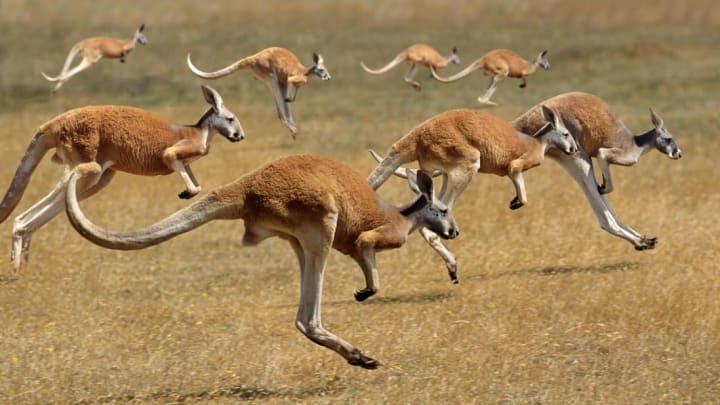Kangaroos are more or less synonymous with Australia: They appear on the "Australian Made" logo, coins, and even the coat of arms for the country. Here are some more cool facts about these magnificent marsupials.
1. Male kangaroos like to show off.
A study in the Biological Journal of the Linnean Society showed that female kangaroos like a little muscle on their romantic partners. Male kangaroos with larger biceps seem to have more success with mating, and some have even been spotted flexing their guns to attract attention.
2. No, the word kangaroo didn't come from a mistranslation.
A lot of people think the English word kangaroo emerged after Captain James Cook had his ship repaired in what is now Cooktown after it was damaged on the coral reef. There are a couple stories here, but one of the most prominent is that Cook asked a local what the animal was, and the local responded with what sounded like kanguru. The word supposedly meant "I don't know," but that was debunked by linguist John B. Haviland 's study on Guugu Yimithirr, the language of the area. There's a debate over what Cook wrote in his journal to describe the animal, but it was later found that gangurru does refer to a species of kangaroo in Guugu Yimithirr.
3. Kangaroos are different from wallabies.
While kangaroos (which grow to about 8 feet tall) are much bigger than wallabies (which stand between 12 and 24 inches tall), there's more to it than just size. A wallaby has brighter coloring than a kangaroo, and they also have different teeth, which is how scientists distinguish the two. Wallabies also eat leaves while kangaroos prefer grass.
4. There are terms for kangaroos depending on their sex and age.
For many animals, males are boars or bucks while females are sows or does. These terms occasionally apply to kangaroos as well, but they're also referred to as jacks or boomers for males and jills or flyers for females. Young kangaroos are joeys (of course). A group of kangaroos is a mob or troop, and a group of tree kangaroos are called a colony.
5. Kangaroos can hop incredibly efficiently.
Kangaroos are the largest animal known to hop. They have feet specially designed for it and use their tails for balance and to help them move. But why do they do that? Scientists say it's the most energy efficient way to get around, which is important, because kangaroos have to cover large distances with little food or water.
They're also pretty good at swimming. It's the only time they can move their hind legs independently of each other. Other than when they're in the water, they really can't get around on all fours.
6. Kangaroo meat is a traditional food.
Kangaroo meat was a source of food for Aboriginal people. Their meat is thought to help combat obesity because it's really lean—about 2 percent fat. If you want some, though, you'll have to be careful how you get it. Kangaroos are protected by federal legislation in Australia, and their meat usually only comes from specially licensed hunters as a part of population control programs.
7. Cars and kangaroos don't mix.
Kangaroos are sort of like the Australian equivalent of deer. They get confused when they see headlights of cars and end up jumping in front of them. Kangaroos are much faster and heavier, though, so the impact can be much worse. To help solve this problem, cars that frequent areas without roadside assistance can be fitted with "roo bars"—similar to bull bars—to limit damage.
8. The mascots of several U.S. universities are kangaroos.
Kangaroos represent colleges and universities across the U.S. Austin College in Sherman, Texas, had its mascot supposedly come from Kangaroo Kourts, where upperclassmen would "try" freshmen. The University of Missouri-Kansas City's debate team picked their mascot back in 1936. And the University of Akron in Ohio's female kangaroo Zippy even won the Capital One Mascot of the Year in 2007.
9. Kangaroos aren't confined to Australia.
Although they're definitely the symbol of the nation, kangaroos aren't only found on the Australian mainland. You can also find them in nearby Tasmania and New Guinea. Occasionally, they can also be found in Europe and America, but that's usually only if they break out of zoos.
